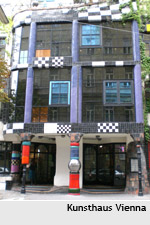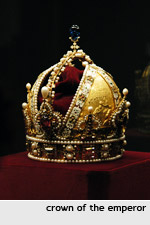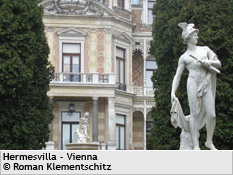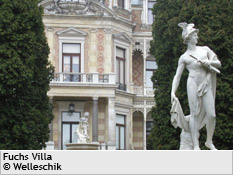THE CITY OF 100 MUSEUMS
Vienna is the city of museums with the most splendid collections in the world. You will find a suitable museum for every special interest. From the Albertina or the Museum of Fine Arts to the Museum Quarter; from the Hundertwasser Museum to the Belvedere. Simply choose from the list below – we will accompany you with pleasure and will impart a lot of interesting information.
visit to a museum of your choice – 2 hours
Rate € 180,- not incl. admission
 Vienna’s most fantastic museums.
Vienna’s most fantastic museums.
The Albertina is an art museum with the largest graphic collection worldwide; 130 years of art history from French impressionism until the present day. Paintings by: Claude Monet, Pierre-Auguste Renoir, Paul Cézanne, Amedeo Modigliani, Henri Matisse, Joan Miró, Pablo Ricasso, Paul Klee, Wassily Kandinsky, Marc Chagall, Kasimir Malewitsch and other giants of art.
Kunsthistorisches Museum (Museum of Fine Arts). This museum is one of the largest and most eminent museums in the world. Contained in the comprehensive collections are items from seven thousand years of history, from the time of ancient Egypt, up to the end of the 18th century. The main focus lies on art of the Renaissance period and the Baroque.
Oesterreichische Galerie im BelvedereThe palace was constructed for Prince Eugene and houses an art gallery. This museum presents the most significant collection of Austrian art, beginning with medieval  times and continuing till the present day. We can admire paintings by Gustav Klimt (the largest collection worldwide), masterpieces by Schiele and Kokoschka, prominent works of French impressionism and the most important collection from the Viennese Biedermeier period.
times and continuing till the present day. We can admire paintings by Gustav Klimt (the largest collection worldwide), masterpieces by Schiele and Kokoschka, prominent works of French impressionism and the most important collection from the Viennese Biedermeier period.
Kunsthaus. This museum contains a permanent exhibition of the Austrian artist and architect Friedensreich Hundertwasser. The main works of the painter are presented together with his graphic arts, his applied arts, his architectural drafts and reports of his ecological commitment.
Museumsquartier (The Museum Quarter). This is a vast complex which combines old and new buildings into a single entity of 20 museums and cultural organisations. You will find museums of art like the Leopold Museum and the MUMOK (Museum for Modern Art), contemporary showrooms like the Kunsthalle, cafés with terraces, shops and bookstores. All this in an area of 60,000 m2 in the centre of the city.
Liechtenstein Museum. The museum in the Liechtenstein Garden Palace has opened its doors to present selected masterpieces from the princely collections in Vaduz, one of the most beautiful and important private collections in the world.
MAK (Museum for Applied Arts). Design is one of the main features of the MAK. The museum shows furniture, glass, china, silver and textiles from the Middle Ages to the present day as well as precious crafts from the Wiener Werkstätte, bentwood furniture by Thonet and Art Nouveau highlights.
 Schatzkammer (The Imperial Treasury). This offers a unique panorama of more than a thousand years of European history. It is located in the Hofburg Palace and it is divided into
Schatzkammer (The Imperial Treasury). This offers a unique panorama of more than a thousand years of European history. It is located in the Hofburg Palace and it is divided into
two sections – Secular and Ecclesiastical. The museum contains a collection of royal objects such as: the insignia and jewels of the Holy Roman Empire, including the Imperial Crown and the Holy Lance, the Crown of Emperor Rudolf II (which later on became the Imperial Crown of the Austrian Empire) as well as precious items from the Order of the Golden Fleece. On display are various valuable gemstones, including one of the world’s largest emeralds – all of this testifying to the former power of the Habsburg dynasty.
Silberkammer (The Silver Collection). The former Court Silver and Table Room presents a unique collection of objects necessary for the running of the imperial household. Among other things, one can admire the famous "Milan Centerpiece," which is almost 30 meters long, porcelain from East Asia, Sèvres and Vienna as well as “panorama plates,” Fayence china, gold and silverware – among them the Vienna Court Silver as well as the "Grand Vermeil Service", an elegant table service for 140 people.
Sissi Museum. The Sissi Museum in the Imperial Apartments of the Imperial Palace compares the myth with the facts. Among the highlights are numerous personal objects once owned by Elisabeth as well as the most famous portraits of the beautiful empress.
 The Hermes Villa. It is located in a former imperial hunting ground, the Lainz Game Preserve. Emperor Franz Joseph once presented his wife, the Empress Elisabeth, with the villa – as a "Castle of Dreams". Today, the Hermes Villa is used for exhibitions. The interior includes paintings by Hans Markart, Gustav Klimt and Viktor Tilgner. On the first floor of the villa are the private apartments of Empress Elisabeth which can be visited.
The Hermes Villa. It is located in a former imperial hunting ground, the Lainz Game Preserve. Emperor Franz Joseph once presented his wife, the Empress Elisabeth, with the villa – as a "Castle of Dreams". Today, the Hermes Villa is used for exhibitions. The interior includes paintings by Hans Markart, Gustav Klimt and Viktor Tilgner. On the first floor of the villa are the private apartments of Empress Elisabeth which can be visited.
Nationalbibliothek (National Library). The former court library is an architectual masterpiece of the Viennese baroque architect Johann Berhard Fischer von Erlach and his son Emanuel. This "castle for books", the largest baroque library in Europe, was erected in the first half of the eighteenth century as an independent wing of the Imperial Palace. More than 200,000 volumes are exhibited here, among them the comprehensive library of Prince Eugene of Savoy.
Hofmobiliendepot. (The Imperial Furniture Collection). The Imperial Court Furniture Depot is a unique museum that shows how the imerial families used to live. The depot stored the furniture of the Habsburgs, kept it in good repair and distributed it to the imperial household when required. The eclectic collection is structured into several galleries that were recently refurbished. In total, there are some 650,000 items on display; many of them were designed by famous artists.
Wien Museum. This museum gives a detailed picture of Vienna's development from Neolithic Times until the present. You will see: art treasures, original sculptures of St.Stephen's Cathedral, furniture, clothes, a very remarkable collection of works by Gustav Klimt and Egon Schiele, the reconstructed apartment of the notable Austrian poet Franz Grillparzer with original furnishings, and above all major paintings by Waldmüller, Amerling, Danhauser and Fendi. This all combines to present a concise and multifaceted impression of the Viennese Biedermeier period.
Sezession (The Secession). It is one of the most important buildings in the Austrian Art Nouveau style. Gustav Klimt had a decisive influence on the design. His Beethoven Frieze – originally created for an exhibition – can be seen in the basement.
 The Fuchs Villa. Also known as the Otto Wagner Villa, since it was built by the famous Art Nouveau architect. The mansion is currently owned by the contemporary painter Ernst Fuchs, who has had it extensively renovated. It houses the Ernst Fuchs private museum with paintings and art objects from the Vienna School of Fantastic Realism.
The Fuchs Villa. Also known as the Otto Wagner Villa, since it was built by the famous Art Nouveau architect. The mansion is currently owned by the contemporary painter Ernst Fuchs, who has had it extensively renovated. It houses the Ernst Fuchs private museum with paintings and art objects from the Vienna School of Fantastic Realism.
Kaisergruft (The Imperial Crypt).The Imperial Crypt is the principal place of entombment for members of the Habsburg dynasty and lies below the Capuchins' church in the middle of the city centre. The bodies of 145 aristocrats are deposited here. They include 12 emperors and 18 empresses.
Wagenburg Schoenbrunn (The Museum of Carriages at Schoenbrunn Palace). The "Wagenburg" building at Schönbrunn is home to the crux of the former vehicle fleet of the Viennese Court. Following the demise of the monarchy in 1918, around 100 carriages, sleds, sedan chairs and litters along with their associated harnesses, saddles and caparisons remained. Since that time, the collection has been expanded to total 170 vehicles. The highlights of the Carriage Collection include the gilded "Imperial Carriage", the Golden Carousel Carriage of Maria Theresa, the Child's Phaeton of Napoleon's son, the Black Hearse of the Viennese court, the personal Landaulet of Empress Elisabeth and the only preserved Court Automobile of 1914.
Heeresgeschichtliches Museum (The Museum of Military History). In five major sections the museum shows the history of the Habsburg empire from the end of the 16th century until 1918 and Austria's fate after the dissolution of the monarchy up to the year 1945. On display:
the automobile in which Archduke Francis Ferdinand was riding and the uniform he was wearing when he was assassinated at Sarajevo in June 1914;the event was the catalyst for World War I). There is also an excellent display dealing with the Austro-Hungarian navy.

